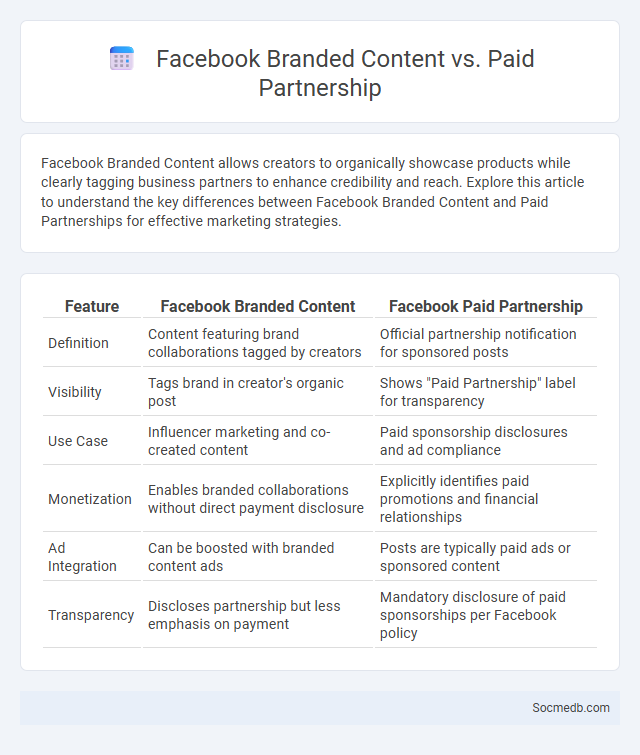
Photo illustration: Facebook Branded Content vs Paid Partnership
Facebook Branded Content allows creators to organically showcase products while clearly tagging business partners to enhance credibility and reach. Explore this article to understand the key differences between Facebook Branded Content and Paid Partnerships for effective marketing strategies.
Table of Comparison
| Feature | Facebook Branded Content | Facebook Paid Partnership |
|---|---|---|
| Definition | Content featuring brand collaborations tagged by creators | Official partnership notification for sponsored posts |
| Visibility | Tags brand in creator's organic post | Shows "Paid Partnership" label for transparency |
| Use Case | Influencer marketing and co-created content | Paid sponsorship disclosures and ad compliance |
| Monetization | Enables branded collaborations without direct payment disclosure | Explicitly identifies paid promotions and financial relationships |
| Ad Integration | Can be boosted with branded content ads | Posts are typically paid ads or sponsored content |
| Transparency | Discloses partnership but less emphasis on payment | Mandatory disclosure of paid sponsorships per Facebook policy |
Introduction to Facebook Branded Content
Facebook Branded Content enables creators and businesses to share sponsored posts that maintain authenticity while promoting products or services. This feature allows you to tag a brand partner directly in your post, ensuring transparency and enhancing audience trust. Leveraging Facebook Branded Content can boost engagement and expand your reach through targeted collaboration.
Defining Paid Partnership on Facebook
A Paid Partnership on Facebook clearly identifies collaborations between creators and brands, ensuring transparency in sponsored content. Your posts will display a "Paid Partnership" label, helping followers recognize authentic endorsements and comply with advertising guidelines. This feature enhances trust and accountability, making sponsored content easily distinguishable from organic posts.
Branded Content: What Does It Mean?
Branded content refers to marketing materials created by or in collaboration with a brand that seamlessly integrate the brand's message into engaging, relevant storytelling on social media platforms. This type of content aims to build trust and foster a genuine connection with your audience by providing value rather than overt advertising. Understanding how to effectively leverage branded content can enhance your brand's visibility and drive meaningful interactions across channels like Instagram, Facebook, and TikTok.
Key Differences Between Branded Content and Paid Partnership
Branded content involves organic collaboration where a brand creates content that aligns seamlessly with its identity, fostering authentic engagement with your audience. Paid partnership signifies a formal relationship where both the brand and the content creator are transparently acknowledged, often featuring sponsored posts prominently labeled to comply with advertising standards. Understanding these distinctions helps optimize your marketing strategy, ensuring compliance and maximizing brand visibility on social media platforms.
Benefits of Facebook Branded Content for Brands
Facebook Branded Content enables brands to reach highly targeted audiences by leveraging authentic creator partnerships, enhancing brand credibility and engagement rates. Through integrated storytelling features and native ad formats, brands benefit from increased visibility and improved conversion metrics. Data-driven insights from Facebook's analytics tools allow precise measurement of campaign effectiveness and optimization of marketing strategies.
How Influencers Use Paid Partnership Features
Influencers leverage paid partnership features on social media platforms like Instagram and TikTok to transparently disclose brand collaborations, enhancing trust and compliance with advertising regulations. These features enable influencers to tag brands directly in their posts, improving content visibility and tracking by advertisers. By utilizing paid partnership tags, influencers optimize audience engagement and streamline monetization efforts through sponsored content.
Compliance and Transparency in Branded Content
Ensuring compliance and transparency in branded content on social media involves adhering to platform-specific advertising guidelines and clearly disclosing sponsorships or partnerships. Your audience expects honesty, which builds trust and protects your brand from potential legal issues related to misleading promotions. Using standardized hashtags and visible disclaimers helps maintain transparency and aligns with regulatory requirements from authorities like the FTC.
Performance Metrics: Measuring Success
Tracking social media performance metrics such as engagement rate, click-through rate (CTR), and conversion rate provides critical insights into your campaign's effectiveness. Analyzing these key indicators enables optimization of content strategy to increase reach, boost brand awareness, and improve return on investment (ROI). You can leverage tools like Google Analytics, Facebook Insights, and Hootsuite to measure and refine your social media success accurately.
Best Practices for Brands and Creators
Consistently engaging with your audience through authentic content fosters stronger brand loyalty and enhances visibility on social media platforms. Leveraging data analytics helps brands and creators tailor posts to peak engagement times, optimizing reach and impact. Prioritizing a clear, consistent brand voice across all channels ensures your message resonates and builds long-term trust with followers.
Choosing the Right Approach for Your Campaign
Choosing the right approach for your social media campaign involves identifying your target audience and selecting platforms where they are most active, such as Instagram for influencers or LinkedIn for B2B connections. Tailoring content to fit the unique formats and engagement styles of each platform maximizes reach and interaction. You should also analyze past campaign data to refine strategies and optimize performance based on audience response metrics.
 socmedb.com
socmedb.com